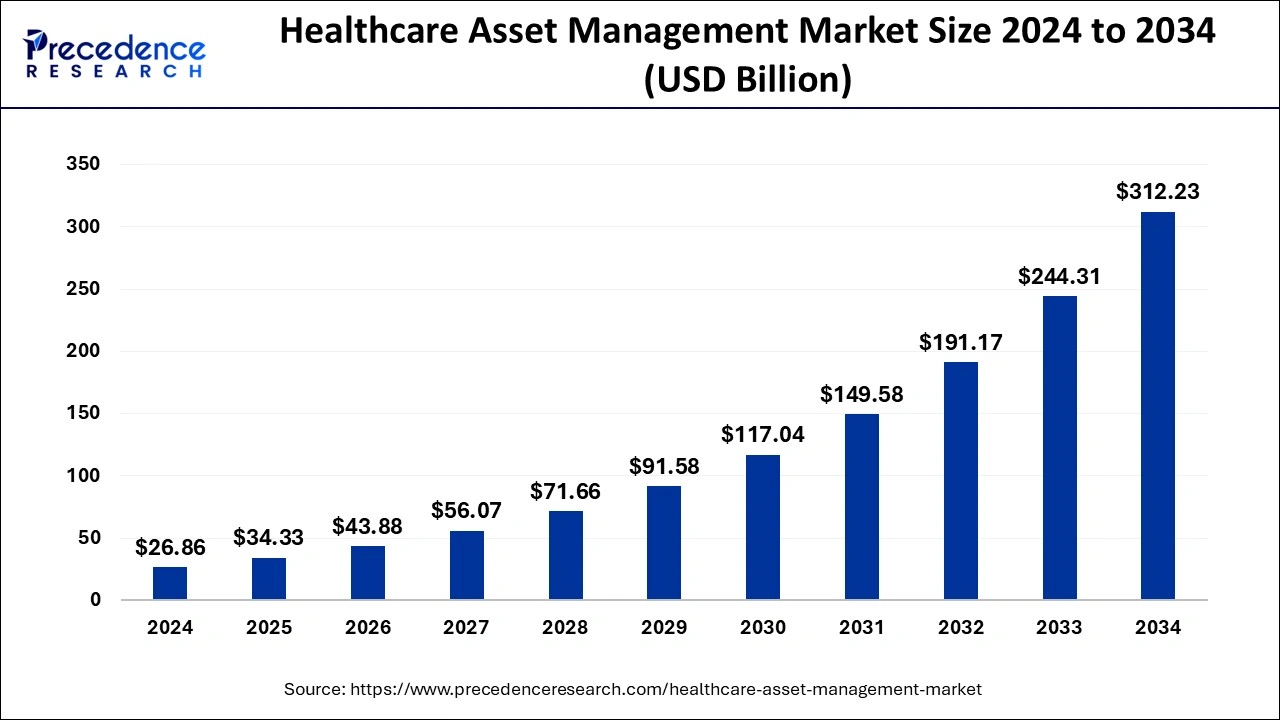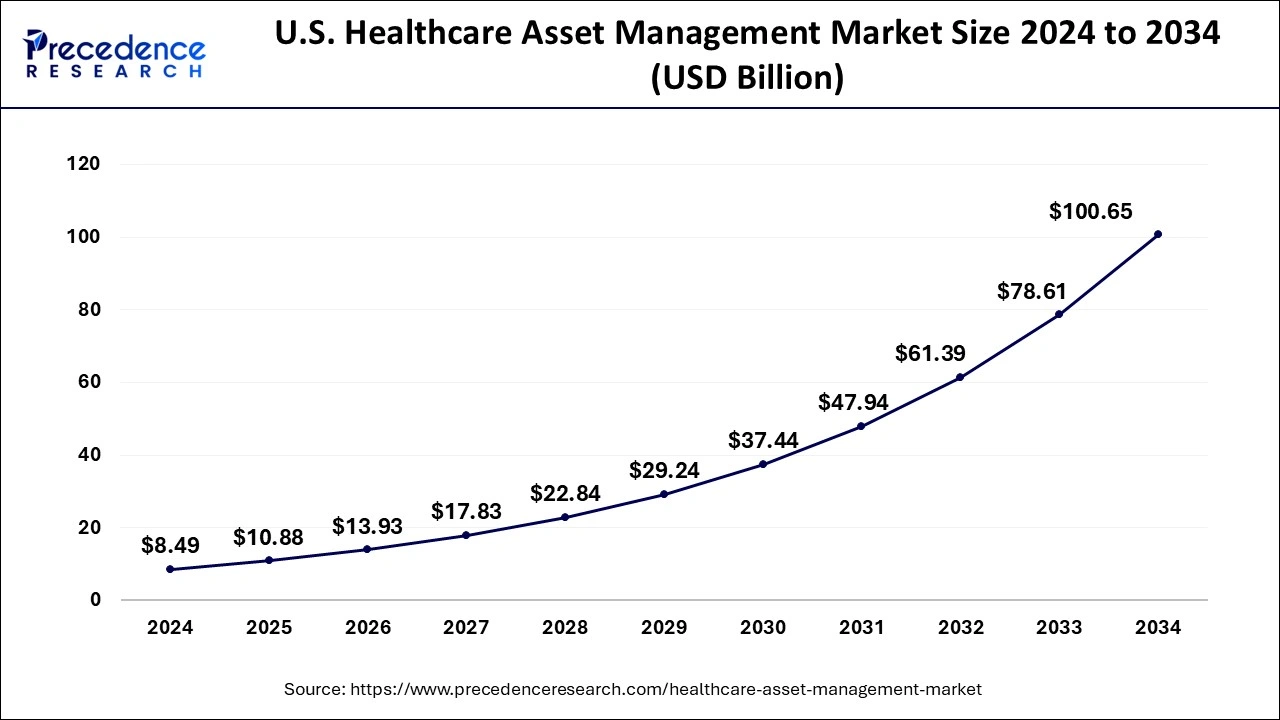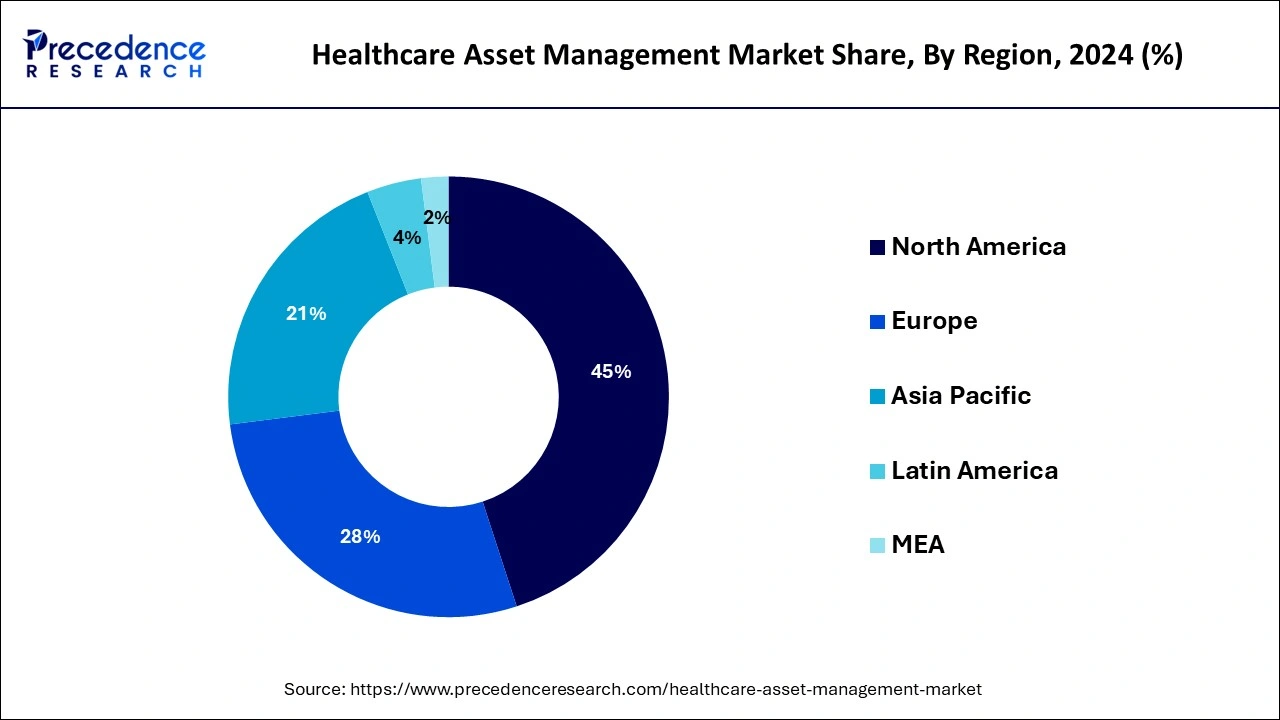January 2025
The global healthcare asset management market size was USD 26.86 billion in 2024, calculated at USD 34.33 billion in 2025 and is expected to reach around USD 312.23 billion by 2034, expanding at a CAGR of 27.8% from 2025 to 2034.
The global healthcare asset management market size was accounted for USD 26.86 billion in 2024 and is expected to reach around USD 312.23 billion by 2034, expanding at a CAGR of 27.8% from 2025 to 2034.

Various healthcare organizations can use AI to improve patient care, boost productivity, support data analysis, and automate workflows. AI-based healthcare asset management systems analyze data from Internet of Things (IoT) devices and sensor readings, equipment usage logs, and maintenance records to predict when equipment might need servicing. This advanced approach allows healthcare organizations to guarantee critical equipment, reduce unexpected downtime, and schedule maintenance before problems occur. For instance, an AI system can detect an MRI machine’s performance deterioration based on changes in its vibration levels and operating temperature. These advanced and innovative factors are expected to enhance the growth of the healthcare asset management market.
The U.S. healthcare asset management market size was estimated at USD 8.49 billion in 2024 and is predicted to be worth around USD 100.65 billion by 2034, at a CAGR of 28% from 2025 to 2034.

On the basis of region, the global hospital asset management market is classified into North America, Europe, Asia Pacific, and the Rest of the world.
The North American region dominated the global market because of the rising quality of structure and the adding use of low- cost medical systems in clinical diagnostic laboratories. Also, increased technology management, the growing need for new technologies to combat fake pharmaceuticals (medicine counterfeiting), and the presence of a well- established healthcare system and a broad network of healthcare service providers will contribute to the segmental growth. Also, the Asia-Pacific region is anticipated to be the fastest growing region during the forecast period due to technological advancements in rising economies like China and India. Also, the growing demand for simple asset management software increased digitization, and adding expenditures in healthcare and expansions by the market player in the region will fuel market growth.

The healthcare asset management market entails cost-effectively and efficiently maintaining and managing equipment, machinery, and physical assets. Pumps, plumbing, compressors, wheelchairs, refrigeration, generators, condensers, mobile beds, heating, ventilation, and air conditioning (HVAC), and other hospital systems are typically included. It saves time and money, increases asset utilization, locates equipment faster, keeps the right inventory on hand, and promotes employee communication.
The growing healthcare expenditure, rising drug counterfeiting activities, and increasing need to enhance operational efficiency are expected to enhance the growth of the healthcare asset management market during the forecast period. In addition, to assist healthcare organizations in asset management, market leaders are developing advanced solutions and technologies that further drive the market demand.
Asset management can be defined as a cost-efficient, highly systematic process for planning, acquiring, operating, deploying, disposing and maintaining of an asset physical in nature of the healthcare business in a medical setting. Also, asset management further supports providing healthcare facilities with the registry of asset in order to track and maintain their inventory. These further aids in decreasing costs and increasing patient care along with efficiencies based on operations management.
An asset management solution for the healthcare industry majorly incorporates everything from ward management, facilities management, layout, intensive care, operation care, and various other facilities. Extreme utilization of assets physical in nature to increase the healthcare quality provided to the patients is an important part of a well-organized management of hospital asset. Furthermore, growing focus towards existing assets effective management along with the workforce have propelled numerous facilities of medical worldwide in order to adopt efficient management technologies and solutions of asset, therefore enlarging market growth of healthcare asset management.
Growing pressure to better manage existing staff has impelled healthcare associations across the globe to borrow effective asset management solutions and technologies. Utmost healthcare associations spend a large portion of their budget on tracking hospital equipment. Therefore, destruction of time in lost assets searching and poor practices of asset management leads to major and sever consequences. According to a study finished by the Nursing Times, nurses of with an average number of 35% spend at least an hour in locating and searching for equipment during an average hospital shift. Thus this not just impacts budgets of the healthcare but also compromises the with the patient care quality provided.
Covid-19 has caused significant disturbance to healthcare stocks, as to the world more generally. While it is assumed that utmost of the impact is likely to be brief and short term in nature similar as delays in order to limited access and elective procedures to healthcare professionals-there are likely to be some further continuing consequences. The wider adoption of technology and the move towards healthcare digitalization has been accelerated by trip restrictions related to Covid19.
| Report Coverage | Details |
| Market Size in 2024 | USD 26.86 Billion |
| Market Size in 2025 | USD 34.33 Billion |
| Market Size by 2034 | USD 312.23 Billion |
| Growth Rate from 2025 to 2034 | CAGR of 27.8% |
| Largest Market | North America |
| Fastest Growing Market | Asia Pacific |
| Base Year | 2024 |
| Forecast Period | 2025 to 2034 |
| Segments Covered | Product, Application, End User, Region |
| Regions Covered | Asia Pacific, North America, Europe, Latin America, Middle East and Africa |
Rising technological advancements and tracking efficiency
The increasing healthcare costs are pushing hospitals to find ways to do more effective things in the market growth. Hospital asset management helps maximize the value derived from every piece of equipment, minimizing waste and optimizing resource utilization. This translates to major cost savings that can be reinvested in new technologies and patient care, further anticipated to drive the growth of the healthcare asset management market.
Lack of data integration and standardization
The lack of standardization across different healthcare facilities is the major restraint hindering market growth. The varying equipment tracking methods and inconsistent data formats make implementing a centralized management system difficult. This creates problems in obtaining a holistic view and hinders data integration of asset usage across departments, further expected to restrain the growth of the healthcare asset management market.
The increasing adoption of IoT devices
The increasing adoption of Internet of Things (IoT) devices facilitates automated tracking and management of medical assets and allows seamless integration with asset management systems. Asset management solutions play an important role in minimizing errors and preventing equipment failures, as patient safety remains a top priority. For instance, Philips Healthcare's IoT-enabled asset tracking solutions enable healthcare providers to monitor the status and location of medical devices virtually. These major opportunities may enhance the growth of the healthcare asset management market in the coming years.
Based on Product, the market is segmented into Radiofrequency Identification (RFID) Bias and Real-time position systems (RTLS). Radiofrequency Identification (RFID) Devices are further segmented into Hardware, Software, and Services. The Real-time position systems (RTLS) are segmented into Hardware, Software, and Services. Further, the Hardware member in Real-time position systems (RTLS) is subdivided into Tags/Badges and Readers/Interrogators. The radiofrequency identification segment dominates the global market due to its technological advancements, locating patients, and assets, drug anti-counterfeiting or preventing drug errors, drug trial compliance, theft prevention, and cost control.
Besides, the growth of healthcare management like locating staff, visitor alarms, accurate & quick assets, and tracing and tracking consumable medicines location is propelling the segment growth in the forecast period. Also, the Real-time position systems (RTLS) sector is anticipated to expand during the forecasted period owing to its management for identifying automatically and tracking the position of people or assets in real-time at a hospital. Besides, rising adoption rates and increased technical developments in these solutions would drive up demand during the forecast period.
The market is classified as hospital asset management and pharmaceutical asset management. Hospital Asset Management is also segmented into Patient Management, Equipment Tracking and Management, Temperature and Humidity Control, Pharmaceutical Asset Management and Staff Management, and Infection Control and Hand Hygiene Compliance which is divided as Drug Anti-counterfeiting. The segment named hospital asset management dominated the market during the forecast period due to the rising need for asset management in hospitals to be held successfully. Amongst these, the equipment management and tracking segment in hospital asset management has the major share in the market, due to a significant growth rate due to the growing demand for asset management in terms of equipment tracking.
The hospitals and clinics segment dominated the healthcare asset management market during the forecast period. This is attributed to the rising usage of asset management systems in healthcare centers and hospitals. The growing number of hospital visits is contributing to the growth and development of the segment. In addition, the growing government initiatives and efforts for the integration of new solutions and technologies in the hospitals and healthcare centers are supporting the healthcare asset management market during the projection period.
By Product
By Application
By End User
By Geography
For inquiries regarding discounts, bulk purchases, or customization requests, please contact us at sales@precedenceresearch.com
No cookie-cutter, only authentic analysis – take the 1st step to become a Precedence Research client
January 2025
December 2024
February 2025
April 2024